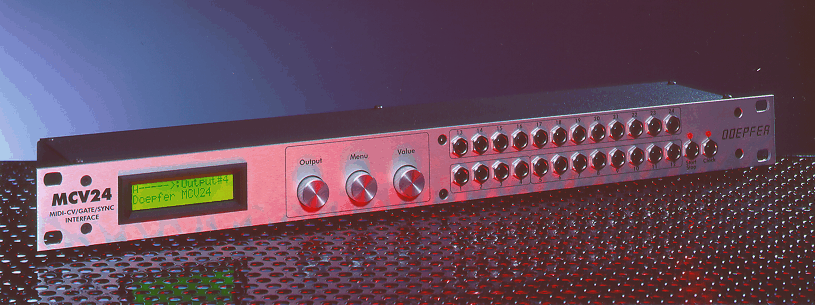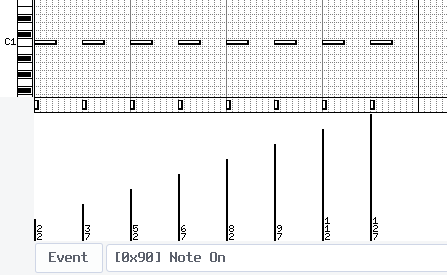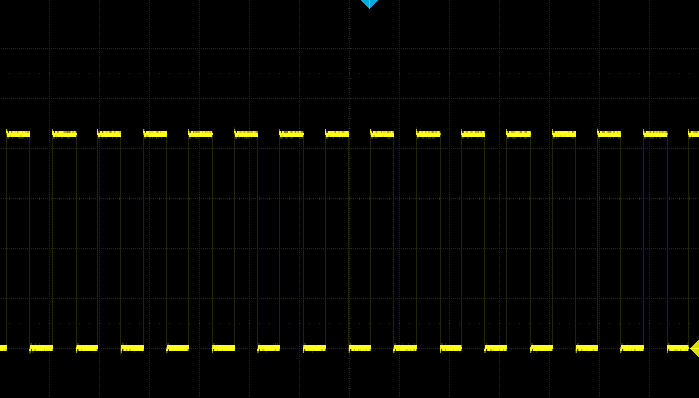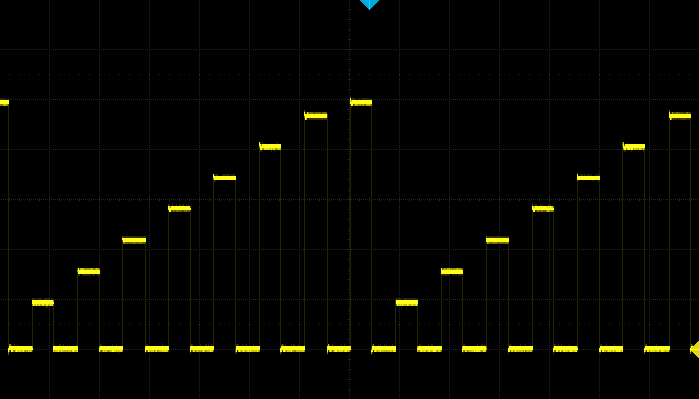Doepfer MCV24
The Doepfer MCV24 is very powerful (and also very discontinued) MIDI-to-CV/Gate/Sync Interface from 1999. It can do an absurd amount of things, however there has never been a complete English manual and the German manual not always clear, so this page is an attempt to compile some findings, and document some features.
Official docs
- File:mcv24_anleitung_d.pdf - German manual (104 pages)
- File:mcv24_man.pdf - English manual (25 pages.......)
Important hardware specs
Each output can be configured individually, but NOT ALL THE INPUTS ARE THE SAME!, the 24 outputs are divided into:
- CV1-CV4: 4 high resolution outputs with 12 bit digital-to-analog-converters (DAC). Especially for pitch control of VCOs following the 1V/Octave standard where high resolution is required (12 bit is equivalent to a resolution of 1/64 semitone). Voltage range -1 ... +6V. Voltage offsets and scales of CV1...4 are adjusted via software. No trimming potentiometers are required.
- CV5-CV12: 8 outputs with 8 bit DACs, optimized for pitch control of VCOs following the 1V/Octave. Resolution 1/4 semitone (jobs like glide/portamento or LFO modulations are not possible due to the rough resolution). Voltage range 0 ... +5.3 V (1 semitone = 1/12 V = 0.083 Volt, 0.083 Volt * 64 = 5.3 Volt). The scale of CV5...12 is adjustable with a trimming potentiometer (normally required only for VCO pitch applications). CV5...CV12 can be used for other functions too (e.g. filter frequency or gate) provided that the voltage range 0...+5.3V is sufficient.
- CV13-CV24: 12 outputs with 8 bit DACs. Voltage range 0...+10V. Resolution 0.04V. Especially for controlling tasks like filter frequency, filter resonance, loudness/ volume, modulation depth and other parameters or for Gate/Trigger applications. CV13...CV24 are not suitable for pitch control of VCOs.
Config tips and tricks
System Parameter?
The submenu System Parameter is a misnomer. It's only to control MIDI/CV settings of a given CV out, a better name would have been Calibration. The device does not really have a system wide parameter config panel (except for sync settings), because everything is centred around the individual configuration or each CV out.
Edit Buffer vs Presets
There are 16 memory presets on the MCV24. When you change parameters on the MCV24, these changes are not done in the presets themselves, only in the edit buffer. The edit buffer is a bit like a scratch pad, and its content will survive if the machine is turned off, but the changes won't make it into any preset unless you explicitly tell the MCV24 to do so. A workflow could be like this:
- Edit a bunch of things
- Save into a new preset
Store->:Preset01 - Change some more
- Save into yet another preset
Store->:Preset02 - Load an entirely new preset
Get<-:Preset03 - Some changes
- Overwrite Preset01
Store->:Preset01
German chromatic scale and pitch notation
All the MIDI notes are configured in the German notation system:
Neo-Latin Do Re Mi Fa Sol La Si English C D E F G A B German C D E F G A H
Similarly, the MCV24 is using a custom Helmholtz note mapping for the MIDI notes, that will be very confusing at first. The German manual does not say anything about it, and the English manual does not offer much info either (they even make a mistake when they attempt to warn that things are a bit different). Basically, MCV24 c is the equivalent to more widespread English MIDI note C3. MCV24 c1 is then logically the equivalent to English MIDI note C4. But then, MCV24 C is English MIDI note C2, MCV24 C1 is English MIDI note C1, etc. So in the end:
English MIDI C-1 C0 C1 C2 C3 C4 C5 C6 C7 C8 C9 MCV24 MIDI C3 C2 C1 C c c1 c2 c3 c4 c5 c6
Dynamic trigger for drums
A popular way to control analogue drum machines is to send a signal to trigger a note-on and optionally send some velocity information, separately, to feed a VCA or something. However, there are also analogue drum machines that will respond to dynamic triggers, in which case the signal received will be use to both trigger the sound, but also depending on the voltage, it will affect parameters like amplitude, attack, decay, pitch, etc, depending on the circuit.
Doepfer made a downloadable preset to demonstrate how to deal with the classic triggering involving the use of CV out pairs to send the two signals, trigger and velocity, separately. On a machine drum that uses dynamic triggering that will work out fine to trigger the sound, but obviously it will always sound the same as the voltage received will never change given that the velocity information is redirected to another CV out.
However, it's perfectly possible to use the MCV24 to turn MIDI note-on + velocity into one dynamic trigger signal! After some digging, here's how I managed to do it (using any of the 13-24 CV out because we don't need much resolution):
- Select
Output13, we will make it play a BD at MIDI note C1 CV Parameter:
MidiTo: NoteEvent EditCV1/Midichannel: 010 EditCV1/Mode: LowN&Follow EditCV1/BaseNote: C1 EditCV1/From: C1 EditCV1/to: C1 EditCV1/Slew: Off Veloci./Mode: Direct Veloci./>1: Output13 Veloci./VelSlewTime: Off Tigger/Mode: No EditCV2/MidiTo: NoEvent
System Parameter:
Edit/Name: Output13 Tune/Mode: Volt/Octave Tune/Note#1: 000 Tune/CV#1/coarse: 000 Tune/CV#1/fine: 000 Tune/Note#2: 127 Tune/CV#1/coarse: 127 Tune/CV#1/fine: 000 Trigger/LevelOn V %: 100 Trigger/LevelOff V %: 000
- Fine tune to your liking and in relation to the trigger threshold sensitivity of the drum machine. To add another CV, you can reuse the exact same parameters, just change the MIDI range of
EditCV1/FromandEditCV1/To
Exporting/Importing presets
The MCV24 is continuously ready to send and receive System Exclusive MIDI messages (Sysex).
Export
- Computer:
amidi -r preset.syx -p hw:1,0 # Adjust to correct MIDI interface
- MCV24:
Preset&Utilities - MCV24:
Send Editb./Pres - MCV24: select the
EditBuf.or one of the 16 presets - MCV24: press the "Value" button to start sending the data. When the MCV24 displays
Ready !then it's done - Computer:
SIGINTamidi
Ctrl-C
Import
IMPORTANT: you cannot change the target memory slot (unless you edit the Sysex file). If a preset was exported from memory slot 4, it will be automatically imported into memory slot 4. Likewise if you exported the Edit Buffer into a Sysex file, when you import the file it will be loaded in the Edit Buffer.
- Computer:
amidi -s preset.syx -p hw:1,0
- MCV24: The preset should be ready as soon as
ReceiveSysEx:XXXis displayed.
Reset
If the MCV-24 gets stuck, press all three buttons together to initiate a cold reboot. This will effectively reset the Edit Buffer. All changes that were not saved into a preset will be lost.
Troubleshooting, limitations and bugs
Trigger direct switch bug
There is an annoying bug, that got me confused for quite some time and seems to be completely undocumented anywhere: if you configure a CV out to output a trigger gate on a MIDI note even (could also be a problem for other modes, did not try), whether you choose ADSR, LFO or Direct. then the trigger will gate will often remain active, even if in some case you have it not assigned to any output! The only way to remove it is to turn off the machine. Super annoying, but if you know the problem, then it's not a surprise any more at least.
ADSR and LFO responsiveness at high MIDI event rates
Doepfer is doing something a bit dodgy... In the first part of their German manual they describe the MCV24 Doepfer as if made of several existing Doepfer modules, they even list the module reference numbers! So after a quick read of the device overview it will seem like the best deal ever. Imagine a €600,- piece of equipment made of 24 times €300,- worth of modules! It seems way too good to be true. And indeed it is... Only later, buried deep inside the German manual they eventually surprise the reader with some bullshit like "of course that's not same as the real modules, what did you think, blablabla...". WTF. And indeed it's not the same, and even though both the MCV24 own simplified ADSR and LFO circuits are quite good, steady and clean, they will struggle under pressure.
Generally when you flood the MCV24 with MIDI note events, it manages to keep track of everything if the operation solely consists into turning all this stuff into trigger gates and velocity. But if you want to trigger an ADSR or LFO, it will start to skip a few at high rates, and eventually be completely unable to produce any envelopes. To be sure, this won't be noticeable for most applications, but makes the features useless for applying super tiny envelopes on high MIDI rate note events for effect and what not. Retrigger does not seem to have any impact on this limitation.
Note length and trigger gates
The MCV24 is fast but not fast enough to correctly process an immediate switch between a note off and note on event when the MIDI rate is fast. Some events will end up ignored, the workaround is easy, just use shorter note lengths, so that the two events do not happen right next to each other. Even the tiniest gap will work and the MCV24 will remain happy even at absurdly high speeds.
Scope
Generally speaking, the manual can be such a mess, that's not always clear to figure out what exactly happens. I started to use a scope to look at the generated CV signals while configuring things and it helps a lot (also to find bugs like the trigger switch thing).
Further Reading
- MCV24 Info http://www.doepfer.de/mcv24.htm
- MCV24 Firmware 1.04 and presets http://www.doepfer.de/pub/mcv24/mcv24download.htm#MCV24_Versions
- MCV24 notebook from Zoë Blade http://notebook.zoeblade.com/MCV-24_guide.html
- Sound on Sound 2000 review https://web.archive.org/web/20000930223959/http://www.sospubs.co.uk:80/sos/mar00/articles/dorpfermc.htm



